Lesson one

The
inhabitants of a bee hive
The
Females of the hive: The queen and worker bees are produced by
fertile eggs laid by the queen. It is important when beginning a new hive
of bees to have a queen laying fertilized eggs. The bees produced
from the fertile eggs will become worker bees and if you look closely -- this
queen is laying an egg in each worker cell built by the worker bees. She
will lay a thousand eggs or more each day depending on the number of worker bees
in the hive to keep the brood area warm and food enough to feed all the young
larva.
As a new
beekeeper, one of the most important skills to develop is the ability to see
eggs. The egg is small and
hard to see in new comb.
It also helps as a new
beekeeper to have your queen marked. A small dot of paint is placed on the
thorax of the queen bee. The different colors used generally indicate the
year the queen was born. The dot not only aids the beekeeper in finding
the queen but it can provide information such as how old she is and if the bees
replace her for some reason, the new queen will have no mark.
Why eggs
are so important!
The success and growth of a new
hive of bees will depend on the queen's ability to lay eggs producing worker
bees. Worker bees do all the work. A queen is usually surrounded by
worker bees. The queen is an egg laying machine. The worker bees
feed and care for the brood (eggs hatch and become larva which must be fed and
capped over when they get ready to pupate). For a hive to succeed,
the queen must lay enough eggs to replace all the bees that die (worker bees
live about 40 days during the working season) and add to the foraging population
to store enough honey stores for winter. Thus, if you get a package of
bees to start a new hive and the queen is poorly mated or may not be mated at
all, the hive will most likely fail within six weeks because not enough eggs are
being produced to replace all the worker bees that came with the package -- they
most likely will all die within 40 days after you get them.
The first step
in bee management is to determine the likely success of the newly started
package and the queen that came with it.
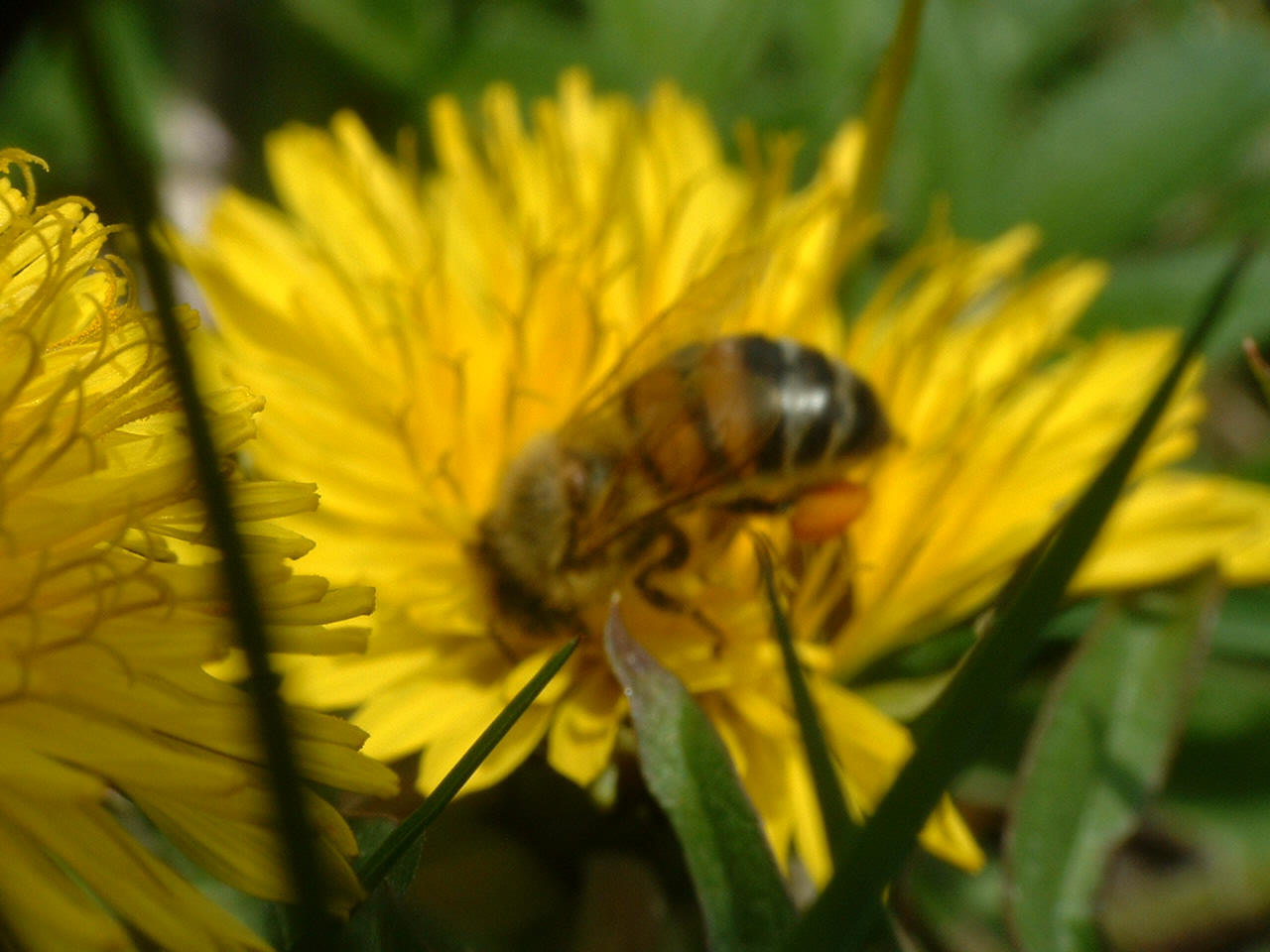
Worker bees gather pollen and
nectar to sustain the bees in the hive. Any animal needs food to survive.
The beekeeper can aid the bees by providing sugar syrup as a supplemental food
source or buy one of the products "patties" that contain pollen and sugar.
Any food given to bees should be available during a cold spell especially in
northern climate condition.
The things that
lead to failure --
The most serious problem is the
queen is not accepted by the bees in the package. The second most serious
problem is the bees may die of starvation and third on the list is the queen is
poorly mated. It is the responsibility of the beekeeper to know what is
happening in the hive during these few critical days because if weeks go by
before a problem is discovered, it will be too late to do much about it.
Remember the worker bees are necessary to the hive's success and if they all die
in 40 days the hive will be lost unless new bees replace them and add to the bee
population. I have seen it all and some new beekeepers are upset because
the bees in their view should be able to survive on their own -- like wild
rabbits, pheasants, deer, or any other wild creature you can name. I am of
the opinion that people who feel this way should not become beekeepers.
I will mention the male bee
later but at this point in a new hive's life, drones (the name for male honey
bees) are not needed. And if you get a lot of males in any package of bees you
purchase, realize that all they will do is consume valuable food supplies that
could be better used to produce worker bees. Later you will develop the
ability to determine if you are getting good packages of bees (few drones and
most of the bees in the package worker bees). A few dead bees will be
found in almost any package of bees but I am talking about a layer of dead bees
on the bottom of the package. Dead bees in the bottom of a package are not
acceptable -- they are sleeping permanently and paying for dead bees is just
dumb.
I may be
getting the "cart before the horse" by talking about bees before
putting your bees into the hive
but you need to understand the honey bee before you go out to buy the equipment
to put them into.
Some people are
making a lot of money taking advantage of new beekeepers who lack knowing what is
a good deal and what is not. I am "old time" and do not take kindly to
individuals selling package bees short of weight or people selling nucleus hives
that are nothing more than started package bees and getting premium prices for
them.
A package of
bees

This is a close up of a package
of honey bees. Most bees are inside the cage but a few can be seen outside
-- these are called hitchhikers. Do not be alarmed -- they generally want
to be with the bees inside the cage but got left out during the shaking process.
The bees in the package got there by being taken from a hive of bees, dumped
down a funnel into the package -- a can of sugar syrup and a queen in a cage was
given to them for the trip to your new hive. This package of bees
has a few dead bees in the bottom of the cage. Not a problem and most
likely what you will see when you receive your package of bees. The can
and the queen cage will not be visible because they are covered with bees.
It may be very
intimidating for a new beekeeper faced with the job of installing these bees
into a hive.
You must have all hive
equipment on hand at the time the package of bees arrive.
Bees can not survive long in a package especially in hot
weather. If they can not be installed the same day they are received a
person can keep them in a dark and cool area. In hot weather a fan blowing
air thru and around the cage is helpful. You know they are too hot when
you do not see them clustered as shown here. Some water sprayed on the
wire screen will help as well -- I am talking a mist of water -- not a full
drenching with the water hose. One secret of those who handle package bees
is spray sugar water onto bees to help conserve the sugar syrup in the can -- A
small garden sprayer filled with sugar water helps. I have a two gallon
sprayer set aside just for this purpose. Do not use any sprayer that has
been used to spray pesticides. Usually three parts water to one part sugar is
used in the spray mix. If the sugar is not well dissolved, it will
plug the spray nozzle.
There are many
ways to put a package of bees into a hive.
The first steps are all much
the same. Check the package of bees when you
pick it up or when it arrives by mail. Yes, package bees are sent
in the mail!
Compare what you see with the
picture above. If there is a layer of dead bees on the bottom of the cage,
ask for your money back. If the bees die after you pick them up it is
generally assumed the bees died because of the way you handled them. So
before you transfer the bees into your vehicle let the shipper know if anything
is wrong. After you drive home it is too late.
Once home treat the package of
bees like you are bringing home a new baby -- Tender Loving Care! See
instructions above.
Make sure all equipment is set
up and ready to receive the bees. That means the foundation needs to be
fastened into the frames and the boxes nailed together. Bees don't seem to
mind if the hive is not painted.
Bees in the package are going
to die everyday. Every day you delay in putting the bees into a hive
reduces your chance for success.
Okay all ready
to go
If the bees have not been
handled properly they will be making a lot of noise and eagerly seeking a way
out of the cage. Cool them down and spray or use a paint brush to put
sugar water on the wire screen of the cage. To avoid a sudden rush of bees
out of the cage be sure they are calmed down or you will regret opening the
cage.
Remove the lid
from the top of the cage
No worry -- bees still can not
get out because the syrup can in the cage blocks their way out. The real
trick is getting the can out of the cage/box so the queen in a cage can be
removed. The queen cage is usually fastened to a wire or tab that holds
the queen near the top of the package and the syrup can.
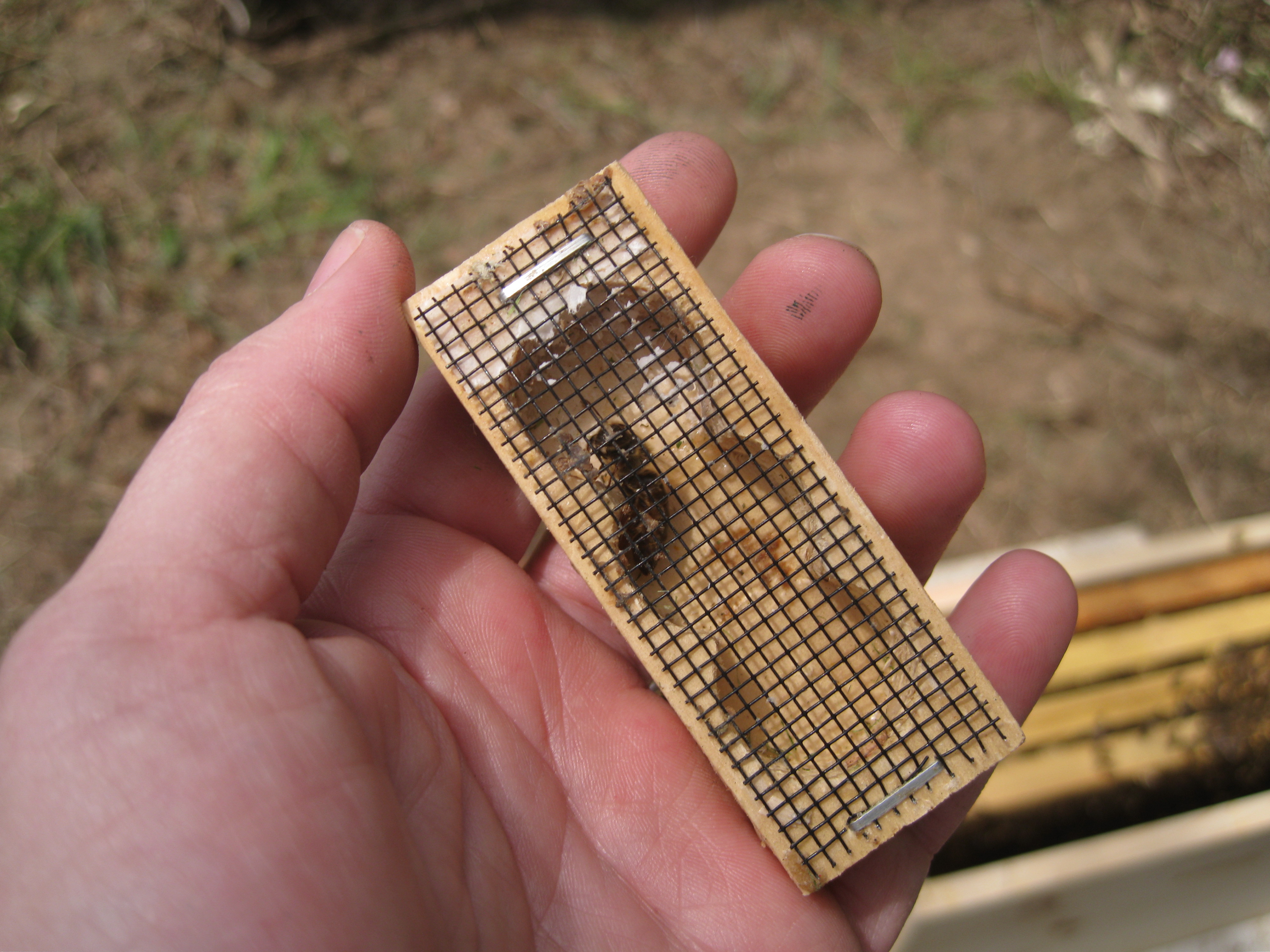
Check the queen
in the queen cage
Queen cages are made of plastic
or wood. The three hole Benton cage shown here is still popular with
package bees shipped out of the south. Is the queen
alive? The queen in the cage shown here is dead. A live
queen should be lively and moving about inside the cage. Read down to see
how to remove the queen cage from the package.
If the
queen is dead Contact the person you bought the package from
immediately and they should replace the dead queen. This is a good
reason to install the bees into a hive as quickly as possible after you pick up
the package. The bees without a queen will not make a hive for you!
It may take several days to get a replacement. If you bought two packages,
you can take the bees with the dead queen and place them together with the good
package. Later when your replacement queen arrives, you can move the hive
you started and set the new hive for the new replacement queen in its place.
Why do it this way? The bees fly from a hive and fix its location into
memory. When they return from the field on foraging trips they return to
the place from which they flew. So field bees will return to populate the
hive with the replacement queen. If you by chance set up the new
hive in a location away from the original hive location and move frames of bees
into the new hive location with the new replacement queen to populate the hive
what will happen? Many of the moved bees will return to the old hive site
-- that was their home location and the new replacement queen will be abandoned
by the bees transferred on the frames -- a few may stay but be prepare to be
disappointed. The young bees moved with a queen laying eggs and not
get flying to forage will generally stay with the moved queen hive.
Be sure to feed both hives well.
If the
queen is alive There are various ways to introduce
queens to a package of bees. Queen cages are referred to as introduction
cages as well. There is a good reason to allow the bees to release a
queen. They do so by eating out the candy blocking the queen's exit from
the cage. The queen is a stranger to these package bees. She is not
their mother and has a strange smell the bees are not accustomed to. Often
if released too soon, the bees will kill the new queen. If the queen is
alive when you open the package that is good. The package producer and
seller has completed their obligation to you. They
will not replace a queen not accepted by the bees because that is considered out
of their control. If the queen later turns out to not lay eggs,
most reliable package producers will replace the queen but not the package bees.
Again another reason to check your hive early so problems can be spotted.
So it is reasonable to ask "How
often should I check my hive?" Ask any two beekeepers and you
will most likely get a different answer from both but I would recommend you
check your queen cage to make sure the queen has been
released in three days. If she is still in the cage after three
days take a nail and push a hole thru the candy that remains to make it easier
for the bees to release her -- generally required with the type of cage shown
above. Any cage with a plastic tube holding the candy does not need a nail
to increase release time. Some beekeepers will tell you it is okay to just
release the queen after two or three days and I can not argue with that but I
like a little insurance by waiting for an extra day or two.
After the queen is out of the
cage you are not out of the woods! The question then
becomes "did the bees accept her?"
Bees almost start building comb
from the moment they are shook into a package. I can usually tell how long
bees have been in a package because I will find comb built from the queen cage
after only two days. If I install a queen cage between two frames
and don't bother to remove the queen cage -- as a beekeeper I have violated what
is called the "bee space" -- the bees will build comb down from the queen cage
to form a sheet of comb between the two frames and not build out the comb on the
foundation where you want it. A frame in your hive might look like this:
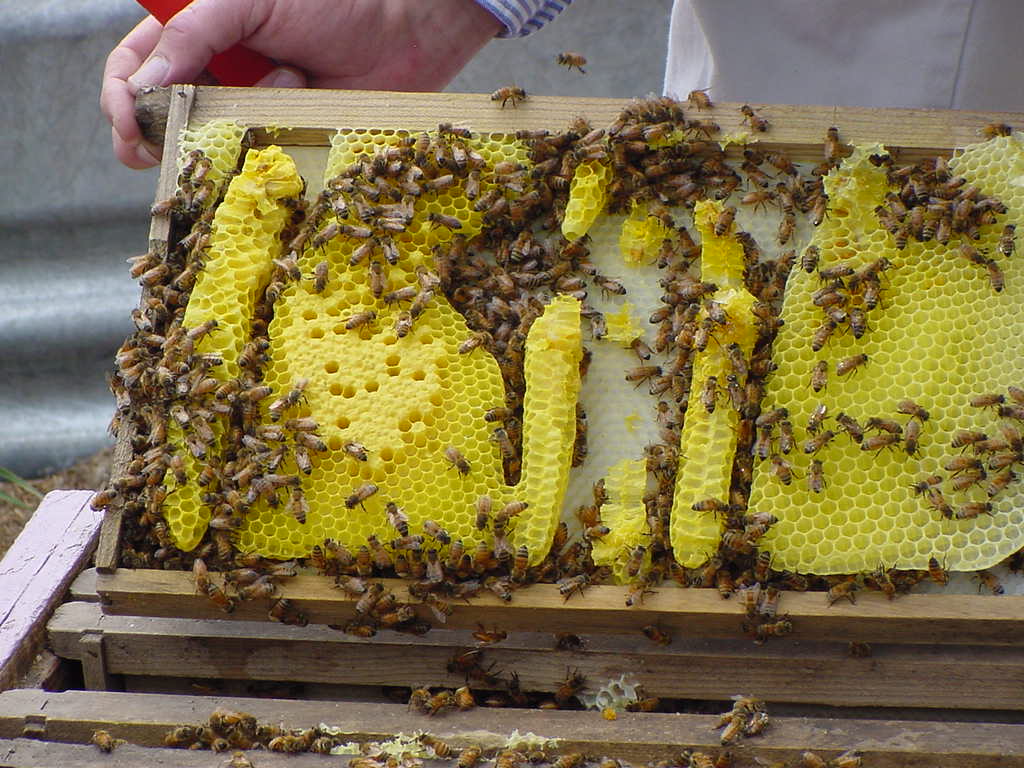
Do you see
where the queen cage was located?
If not look to the top center
of this frame where there is no comb -- just below the light on my
shirt where the frame touches my stomach.
And what else does this frame
tell us? The beekeeper did not bother to check for more than a week or
more because there is brood capped over already in the new comb built on this
frame. Queens begin laying eggs just as soon as the bees can build out the
cells on new foundation. Another issue with this frame is the beekeeper is
using white plastic brood comb. It could also be black or green but the
fact is, a beekeeper using plastic foundation in a hive must use all 8 or 10
frames in a hive body. There can be no extra space between the frames and
new beekeepers are often frustrated with getting bees to draw out comb on
plastic foundation because they buy a hive body with 9 frames rather than 10
frames -- bee supplier makes a little more by not supplying that 10th frame and
the new beekeeper thinks they got a complete super of frames. After all
foundations is drawn out, one can use 9 frames in a 10 frame bee hive body.
Maybe one reason some beekeepers will tell you not to buy plastic. I
rather like black plastic foundation and to me it has several advantages over
beeswax wired frames.
Ask me why?
But I am getting a bit ahead of
myself
"Putting the
queen cage into the hive and getting the bees out of the package"
Remember to
place the queen cage near the food supply given to
the bees from the package. Often beekeepers will place the syrup can over
the inner cover hole as supplemental food for the bees and place an empty super
to protect the syrup can with the top cover placed over it. Queen failure
seems to increase if the queen is located away from the place the bees will
cluster. I have seen queen cages put on the bottom board of the hive.
This may work in warm weather but not cold. I consider the board man
feeder useless in cold weather conditions for feeding a new hive of bees.
It is a feeder placed into the entrance of a hive with a glass quart jar of
sugar syrup serving as the food. In cold weather it is better to use a
feeder that fits over the bees or is inside the beehive where the bees can get
to it. Bee need supplemental feed during cold
weather especially if in a newly started hive.
Remember there are many ways
this is done. Here I am working with a new beekeeper getting ready to install
her packages into her new hives with the assistance of her husband. She is
painting sugar syrup on to the wire of the bee package.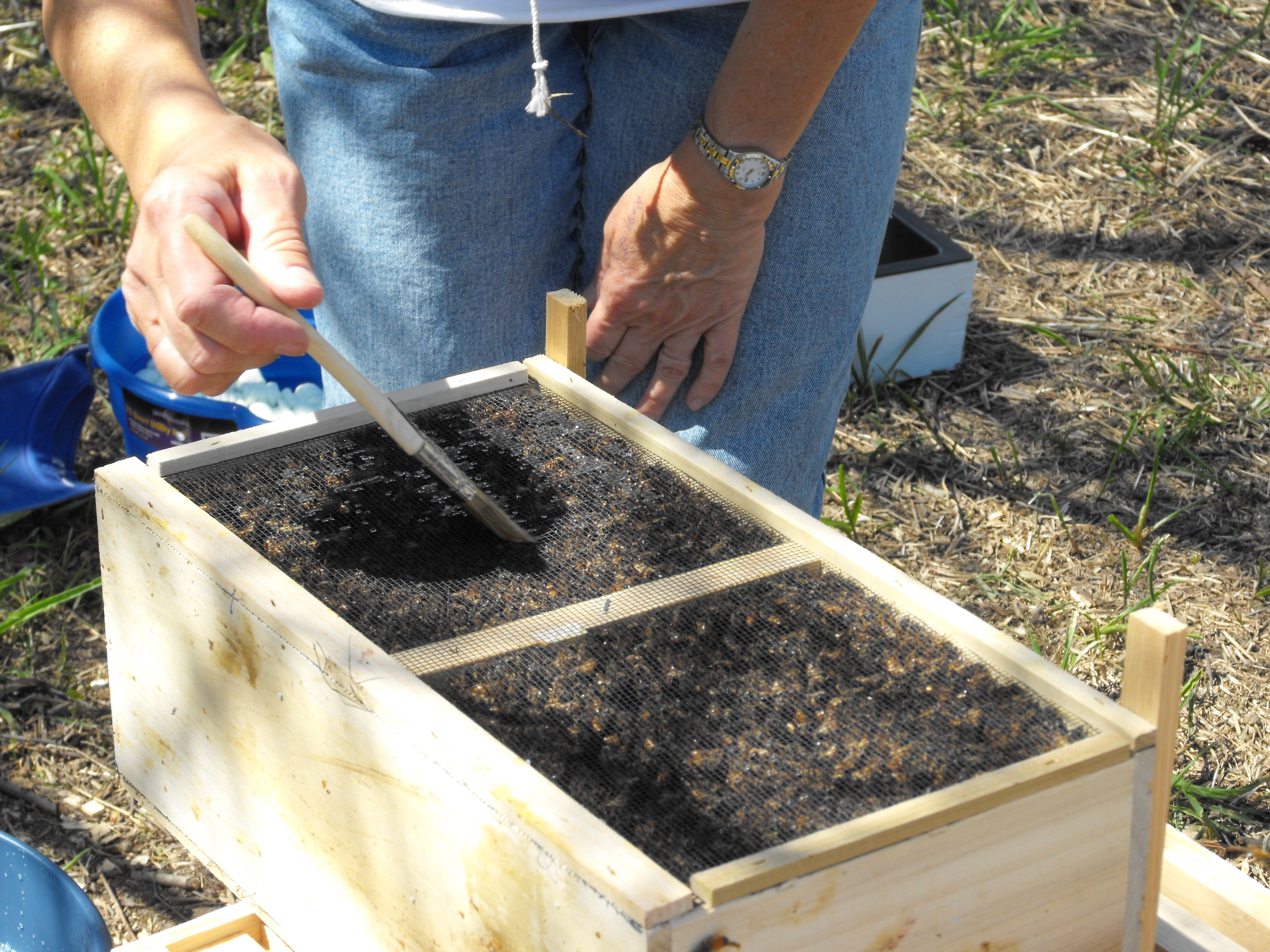
I recommend that a
package of bees should be fed sugar syrup 10 to 15 minutes before the work
begins to remove the syrup can to get the queen cage out of the package.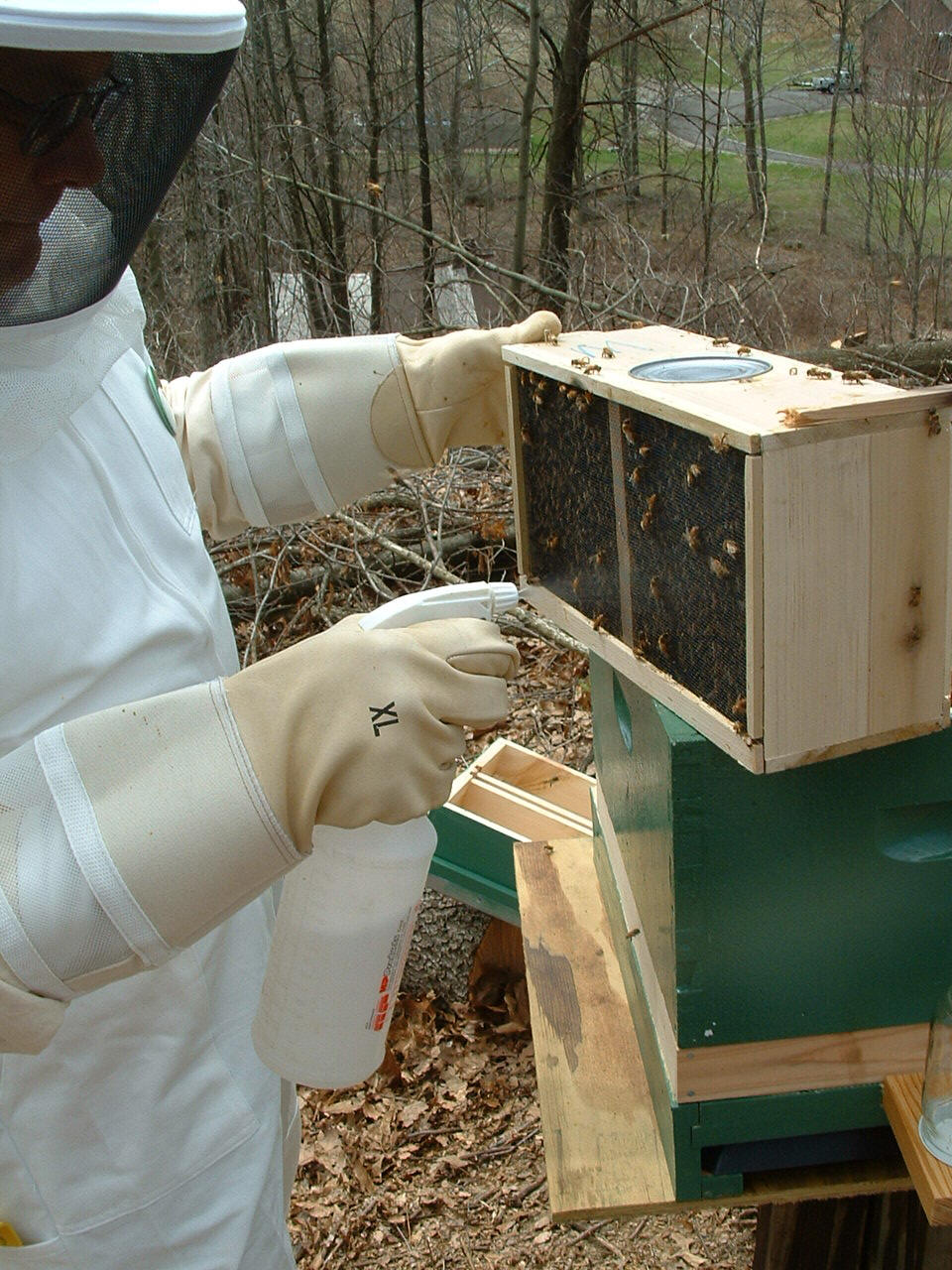
Another new beekeeper I helped did
the same thing in another way. He was a bit intimidated by the bees and
wore gloves. Nothing wrong with that. He is using a small spray
bottle to apply the sugar syrup. You will notice that the bees
settle down quite quickly when the syrup is supplied to them. This
accomplishes two things:
1) The bees being well fed are
less likely to sting
2) The bees are a bit sticky and
clean each other off. They are less likely to fly.
The next step is to remove the
syrup can -- grasp the wire to the queen cage -- remove the queen cage and
replace the syrup can back into the top hole of the bee package. Thus,
bees are still confined to the package.

The syrup can is easy to remove if
the package is laid on its side. The hive tool is handy to get the can
started out of the hole and once started it should come out easy. But easy
does it! Work slow and deliberate. Note the tab is showing beside the
syrup can. This is a 3/4 inch metal tab stapled to the queen cage.
Do not let it slip back into the cage when the syrup can is removed.
When the can is just about ready
to remove, take one hand and hold the tab. As soon as the can is removed
the tab is pulled out with the queen cage attached to it. Quickly reinsert
the syrup can.
A few bees will come out of the
package on the queen cage. This is nothing to worry about.
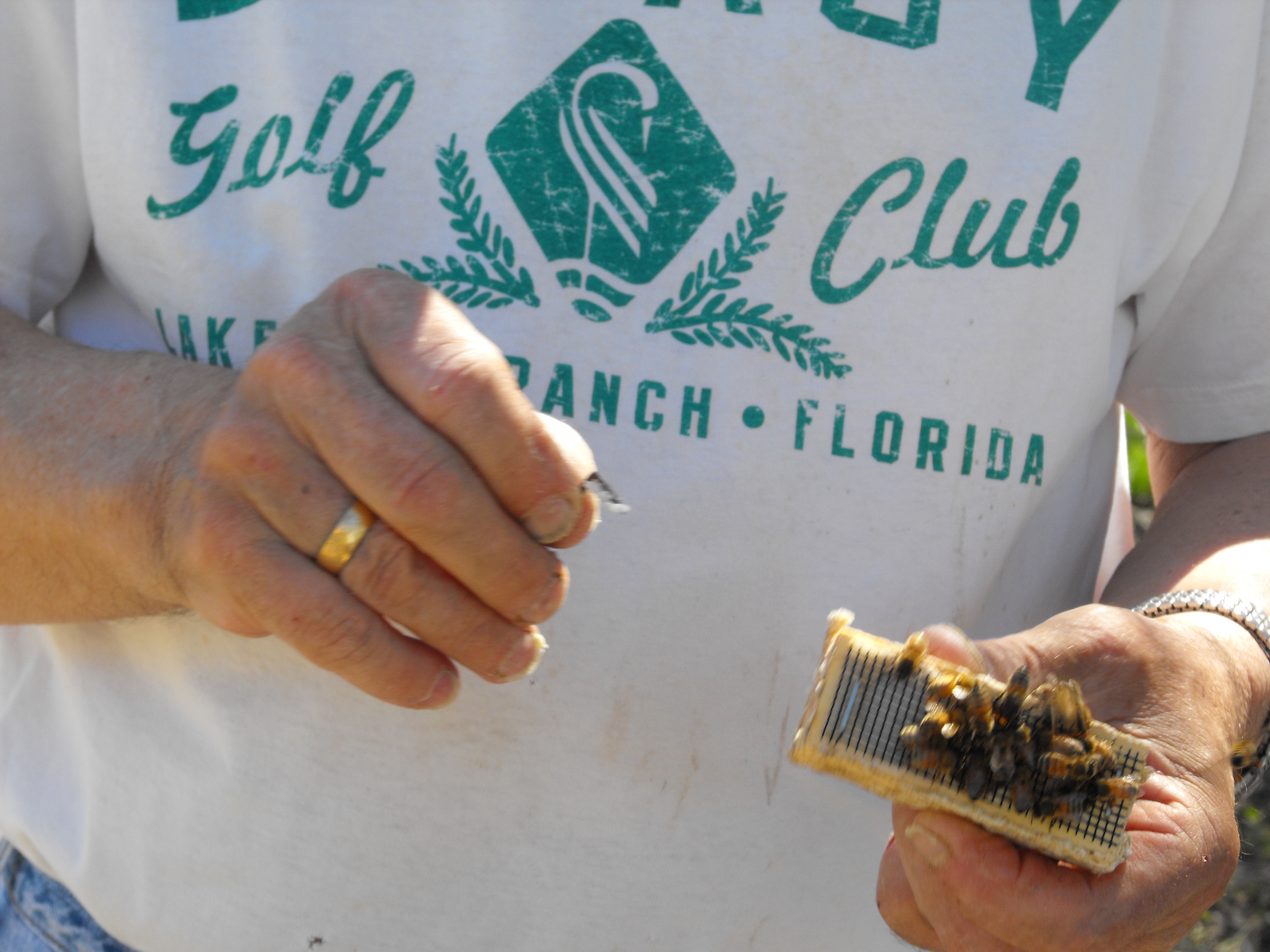
Now that the queen cage is out of
the package, you can relax a bit. The job is to place this cage with
the candy plug removed so the bees can release the queen in due time in the new
hive..

And a quick check shows the
queen is alive and looks very active.
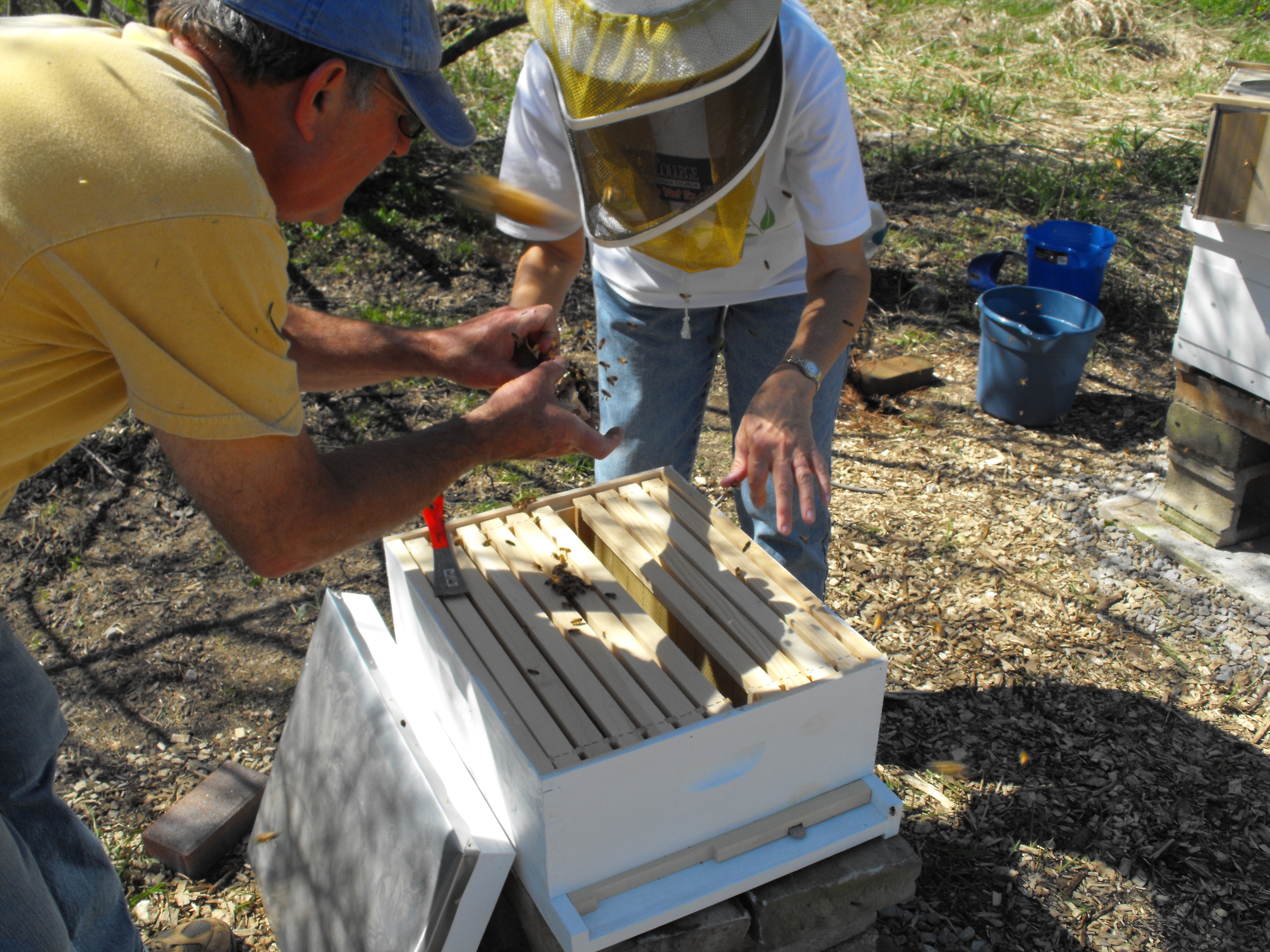
And very gently place the queen
cage between two frames with the screen side down or facing so bees can have
contact with the queen inside. If the wire or metal tab is still attached to the
queen cage, it can be tacked in place with a thumb tack. The candy
end of the cage is for the most put in the up position so any bees that die in
the queen cage will fall down from the candy hole and not plug it up so the
queen can get out. Sometimes a frame must be removed to fit the queen cage
between top bars in a hive. Just make sure you come back in several
days to see if the queen has been released. If she is no longer in the
queen cage -- remove it and slide the frames close together so no gap between
frames exist. If you removed a frame to get the queen cage into the hive,
replace it now!
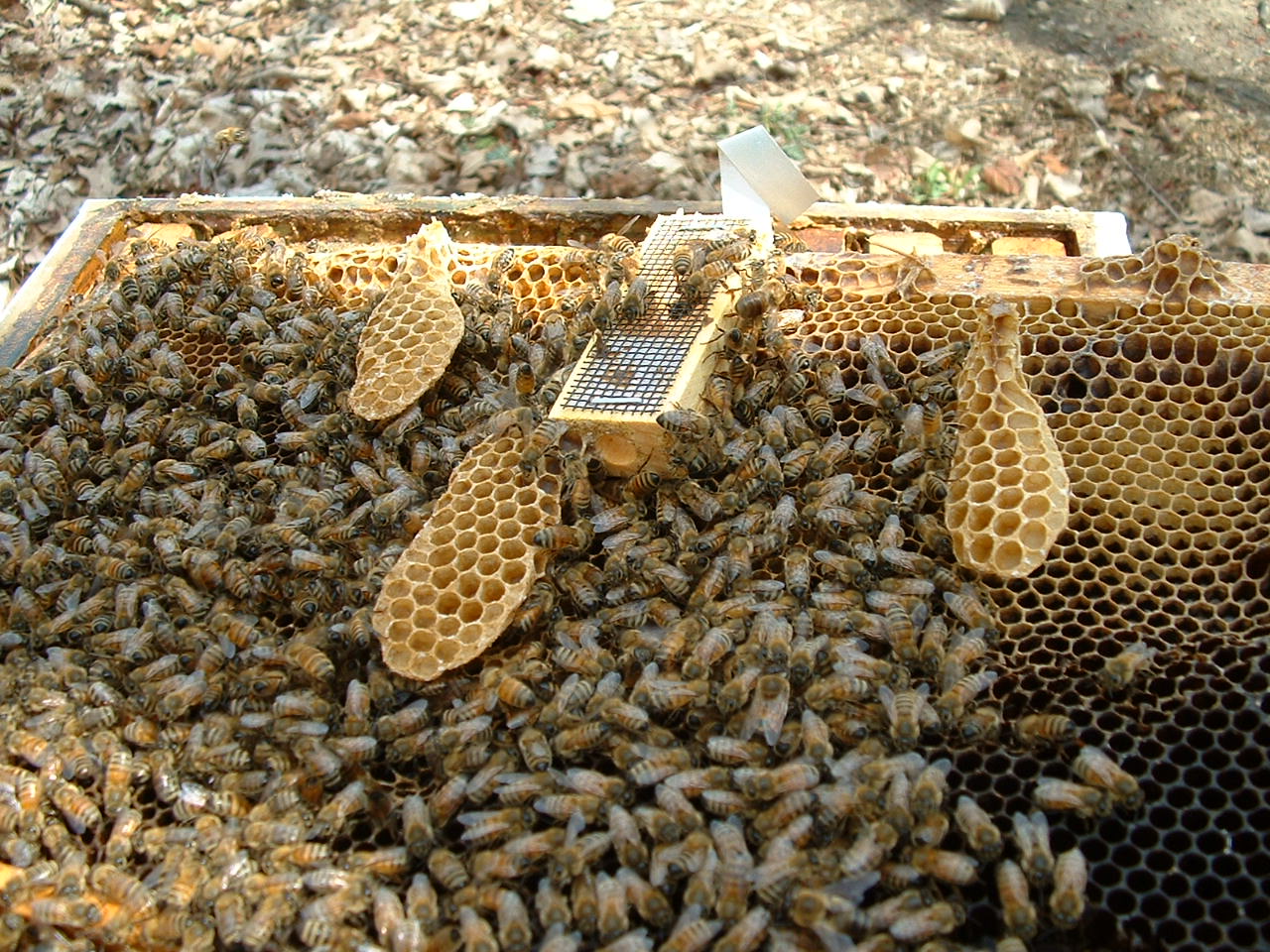
This is not the same hive but this
is what will happen in only a few days. And if you don't remove the cage
and cut out the new comb, you will be dealing with a big mess a bit later on
when you try to remove this frame from the hive.
Once the queen is in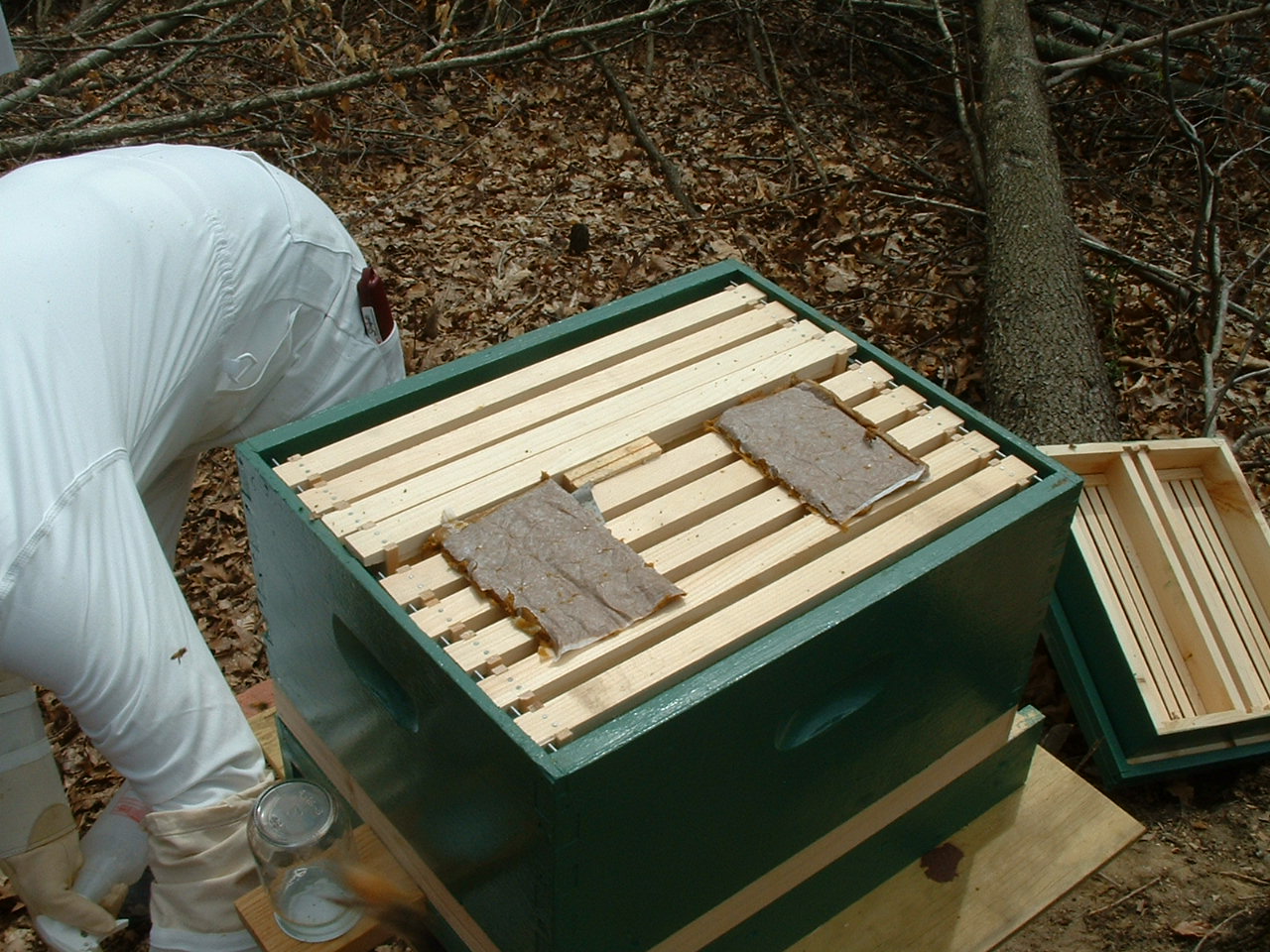 place you can
add pollen patties if you choose. Notice that the queen cage in the picture
is placed squeezed between frames rather than being hung from a tab.
place you can
add pollen patties if you choose. Notice that the queen cage in the picture
is placed squeezed between frames rather than being hung from a tab.
Now is the time
for the bees A
number of ways are used to get the bees from the package into the hive.
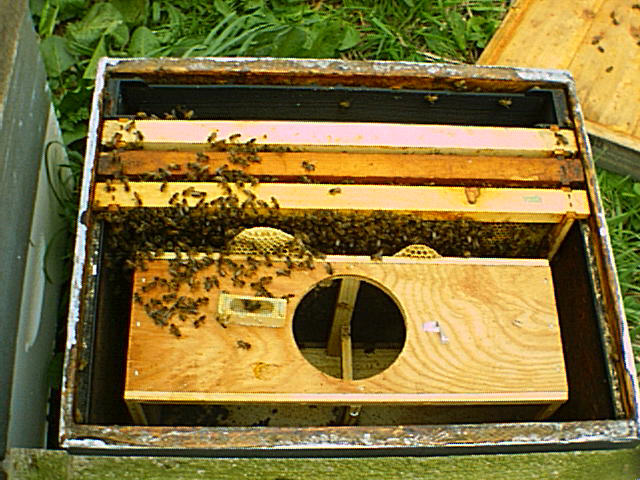
Some place the entire
package in the hive body. It is easy to do. Remove five frames and
set the package with the top hole facing up on the bottom board. Pry the
can from the hole. In this example the beekeeper placed the queen cage on
the package. I prefer to place it next to or between frames. This
hive has a division board feeder. Other methods include top feeders like
shown above ready to be put on the hive with the pollen patties. This is a good method to feed. But
again there are other methods used to feed the hive. If you set the
package down in the hive -- by all means get the package out as soon as the bees
move out of it. If they refuse to move out of it, you will need to shake
them out. Usually doing this later results in some very angry bees.
And in this picture of the package inside the hive, note that the bees have
already started building comb between the package and the frame beside it.
Installing bees
by shaking them directly onto the top of the frames of a hive.
It may seem a bit messy and a
lot of bees might be flying about but it is quick and easy. I
would not recommend this if the bees have not been well fed prior to the shaking
out of the package.
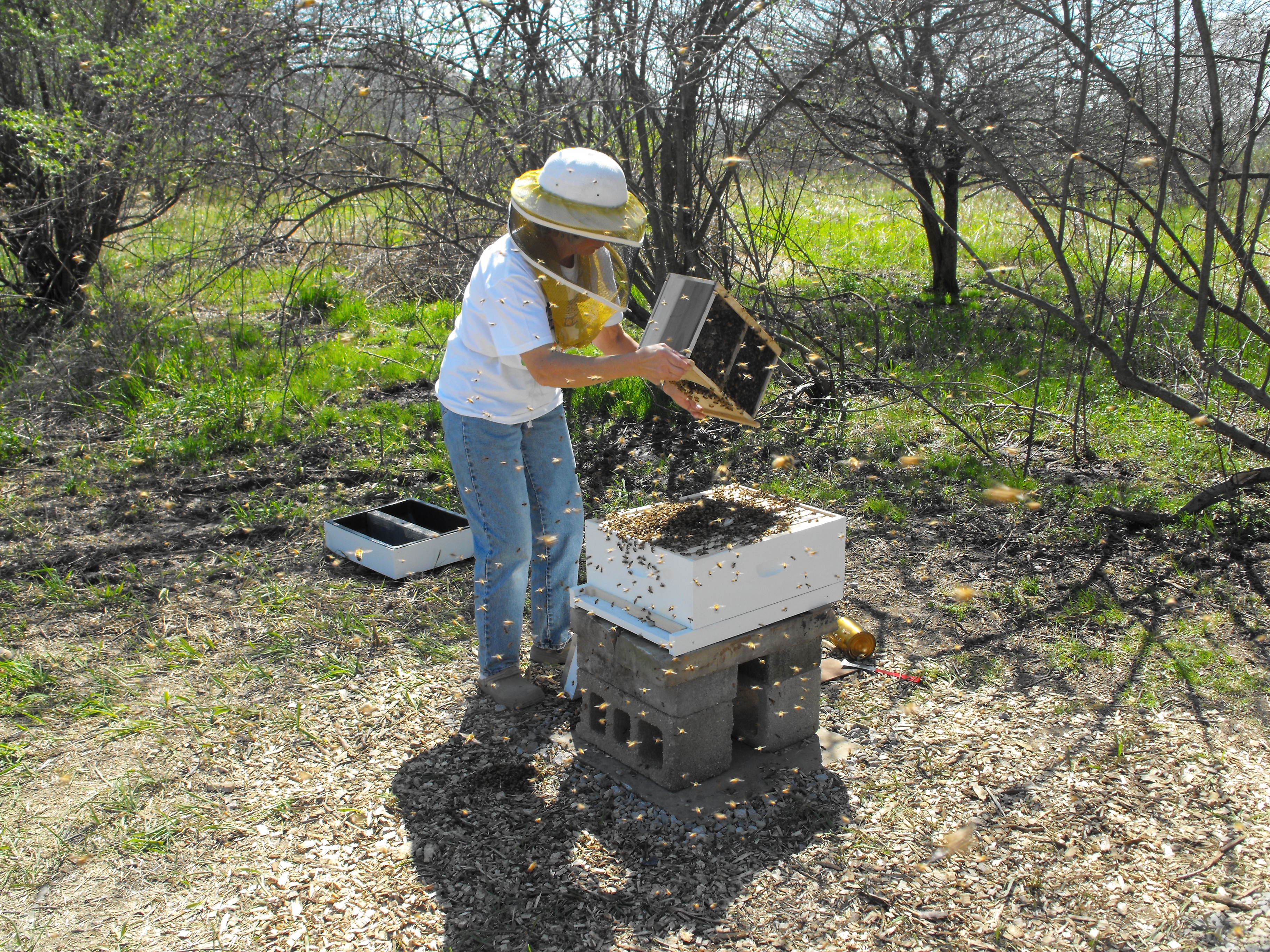
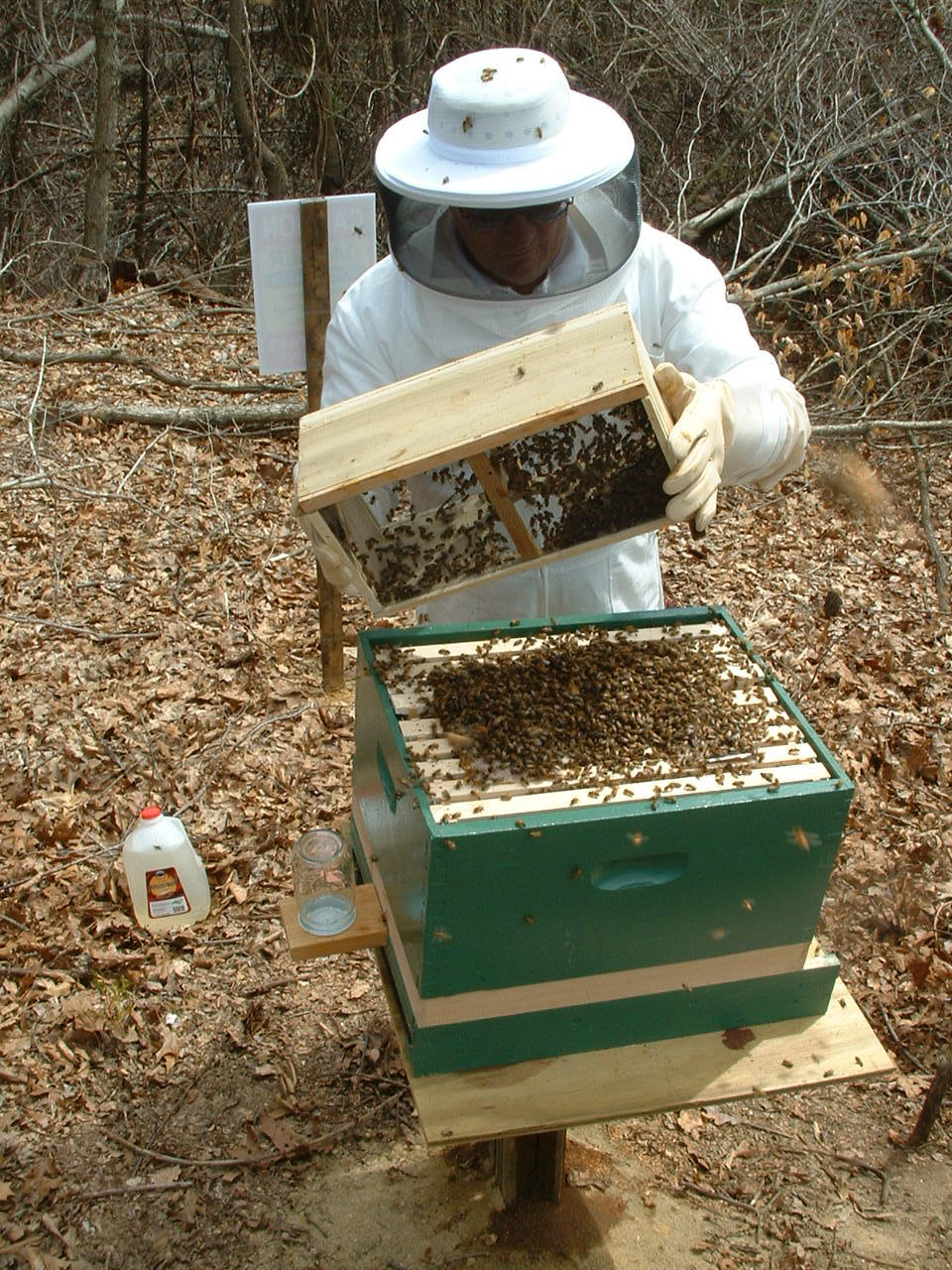
After you install a package or
two -- this is no big deal as long as the bees are fed prior to shaking them onto
the top bars. Can you see the boardman feeder jar placed in
this hive to feed them?
The bees quickly move down
with a little smoke encouragement. You can place the inner cover or top feeder
on the hive after the bees move down on the frames. What could go
wrong?
Well a number
of things!
Don't install your package of
bees into a hive and then take a two week vacation to Alaska.
Don't take on more than you can
handle! Installing one package takes time. Two take more time.
Your hive is
going to require visits to check on the following things:
1) At least three
days after the package is installed in the hive check to see that the queen is
released. If not, you have something to manage.
2) In five day following
the installation, Check for eggs -- if you see them it indicates the queen is
somewhere in the hive. There will be time to see her on another visit.
If you do not see eggs or the queen
it may be a concern:
1) Eggs are hard to see but
it will not be difficult to see the bees working at cell building. You
should see evidence that the bees are building comb. The bee population
should still be close to what it was when you installed the bees into the hive.
The next lesson will cover things (management techniques you will use to help
the hive survive).
3) In ten days you should
see comb being drawn on three to five frames and the cells should be filled with
nectar across the top near the top bar and the rest should be full of eggs and
young larva. I am assuming you are feeding the hive on a regular basis.
4) In fifteen days you
should see capped brood and it would be a good time to check on the queen
if you have not seen her up to this point. Many new beekeepers have
trouble finding queens and it can be challenging sometimes for experienced
beekeepers as well. But the trick is to find eggs on a frame and
look for her where brood is being raised. Do not smoke the hive with a lot
of smoke. Use just enough to cause the bees to retreat just a little.
If you use a lot of smoke you may cause the queen and bees to start running
about the hive -- forget locating her if this happens.
It is my believe that every new
beekeeper should start with a package of bees so they gain the experience to
watch a hive of bees develop. A new beekeeper will also have time to
learn as the bees build up -- it is a gradual process -- not as fast as a
nucleus hive. In beekeeping you can start with a "baby" (a package of
bees) or a "teenager" (a nucleus hive).



